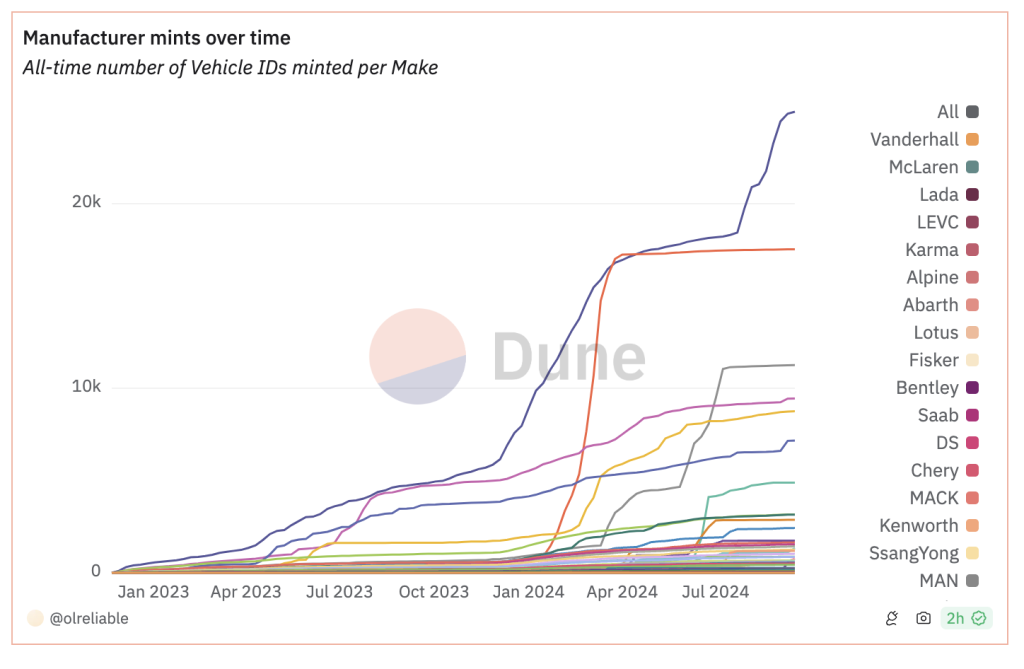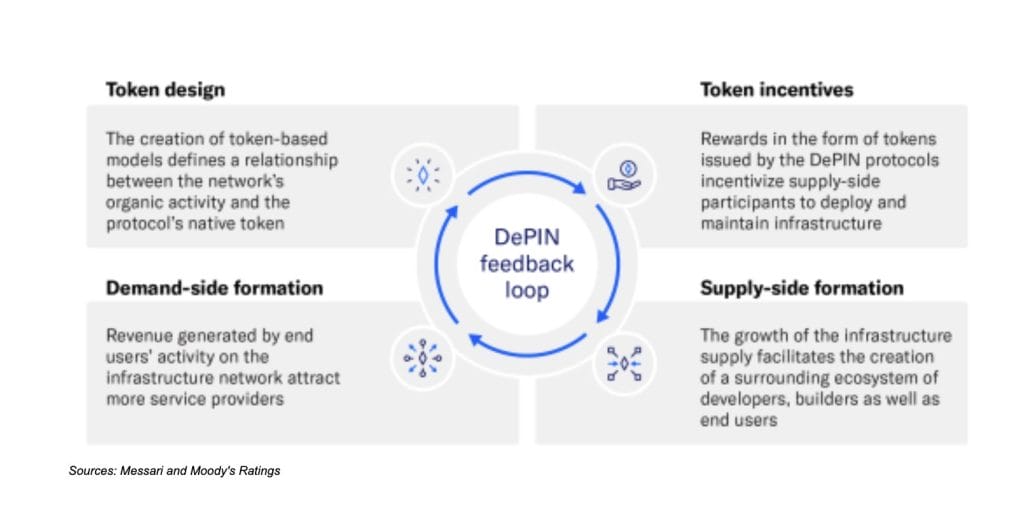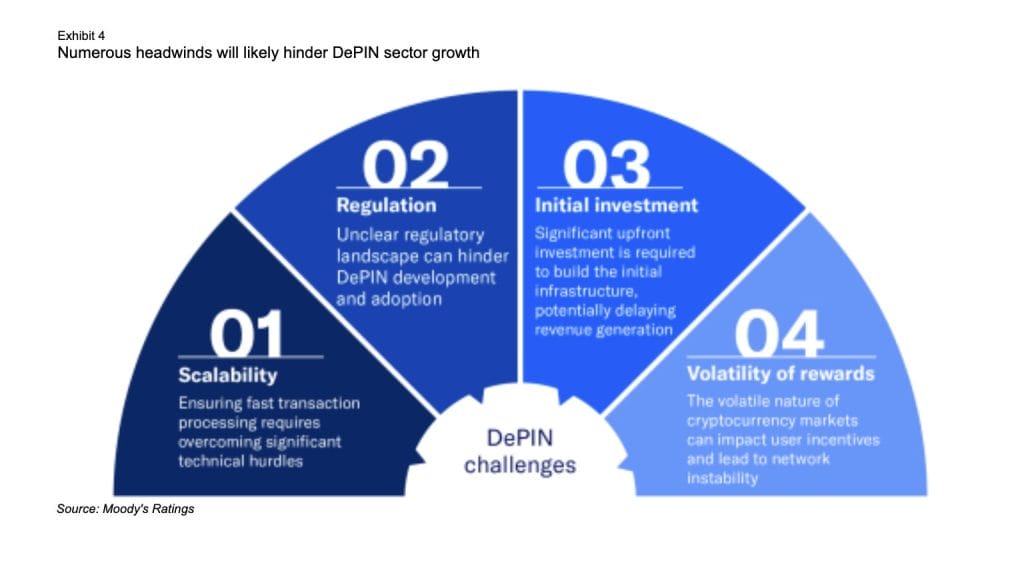Infrastructure-intensive industries are undergoing massive transformations to meet the need for digital innovation. New technologies like artificial intelligence (AI), blockchain, and the Internet of Things (IoT) are being applied to industries that haven’t evolved in years.
Infrastructure-intensive sectors are also moving towards decentralized models. As a result, decentralized physical infrastructure, or DePINs, are quickly gaining traction.
According to a new report from Moody’s Ratings, “How DePINs could build the future of physical infrastructure one token at a time,” the DePIN market has the potential to reach $3.3 trillion by 2030. Findings show that this market was valued at $2.2 trillion last year.
DePIN continues to grow
With fundraising volume up 296% year over year, the total market cap grew 400% to $20 billion.
It’s Time for a #DePIN Sector Update— Messari | Road to #Mainnet2024
(@MessariCrypto) August 7, 2024
DePIN For The Auto Industry Explained
While the concept behind DePIN may seem complex, billion-dollar industries, like the automotive sector, are beginning to demonstrate the transformative nature of these models.
Early use cases show how car owners can own and leverage their data while earning incentives for sharing personal information.
For example, Dimo is a DePIN network built to improve the car ownership experience. Rob Solomon, Co-Founder of Dimo, told Cryptonews that Dimo seeks to make every car on the planet smart and programmable by putting vehicles on-chain.
“Dimo works by giving vehicles an on-chain identity,” Solomon said. “Users mint their vehicle on-chain to create a digital twin of the car. We then connect the digital car to the Dimo platform via a vehicle ID.”

Solomon explained that the data generated from a user’s car is recorded off-chain. This includes the speed, location, and other information generated over time.
Users are then able to share that data with Dimo if they choose to do so, earning tokens as an incentive.
“The Dimo token is live, and anyone who connects their car automatically earns Dimo tokens weekly as a baseline reward,” Solomon said. “Users also have the choice to share their data to earn additional rewards that go directly to the Dimo wallet.”
According to the Dimo protocol dashboard, 112,311 cars are connected to Dimo, with over 36,000 vehicle ID holders.
User Data Streamlines The Auto Industry
While drivers can earn passive income by connecting their cars to Dimo, the data generated can streamline traditional processes within the auto industry.
Solomon believes that Dimo will enable new types of use cases that companies can build out over time.
For example, he mentioned that car insurance agencies can partner with Dimo to access data from the platform.
“Insurance companies can’t access important data from drivers and their vehicles, so they are looking for a better way to connect with users. They see Dimo as a way to do this,” he said.
Another use case Solomon believes will soon be possible is having cars connect directly to parking garages.
“Once a vehicle enters a garage, a payment will already be secured, and the car will know exactly where to park,” he noted.
Car Data Helps With Mapping Accuracy
Another interesting automotive DePIN use case is being enabled by a street-level mapping project called Hivemapper Network.
Ariel Seidman, Co-founder of Hivemapper Network and the CEO of the Bee Maps brand, told Cryptonews that Hivemapper contributors could help build digital maps by collecting high-quality, street-level imagery with dashcams connected to their vehicles.
“Traditional mapping solutions often struggle with keeping data current, especially in rapidly changing urban areas or less accessible regions,” Seidman said. “Hivemapper’s decentralized approach allows for real-time updates and ensures that map data is both fresh and reflective of on-the-ground realities.”
Hivemapper seeks to solve the problem of digital mapping accuracy. According to recent statistics, drivers using Google Maps across 56 journeys, covering 18 miles in 32 minutes, found that driving time accuracy was 23% and journey length accuracy was 38% correct.
It was also noted that every month, over a billion people access Google Maps to find destinations and determine optimal routes.
“By enabling individuals and fleets to contribute to the map, Hivemapper ensures a more comprehensive coverage that can cater to the diverse needs of users across a region,” Seidman noted.
This is especially important as demand for real-time, accurate map data is growing. This is being driven by the rise of autonomous vehicles, advanced logistics, and emerging technologies that depend on precise geospatial information.
Although Hivemapper is taking a new approach to mapping systems, the network already contains 10 million miles of map coverage.
According to Seidman, Hivemapper has added coverage five times faster than Google Street View.
It took 10 years for Google Street View to map its first 10 million unique miles of roads. https://t.co/pqhk13MIfV
Our incredible Hivemapper community hit that mark a few hours ago. It took 1 year, 10 months and 16 days.
There's a better way to map our world. It's here. pic.twitter.com/isYPUHIOLB— Hivemapper (@Hivemapper) September 19, 2024
“The network already offers unique coverage for more than 26% of the world’s roads, with the strongest coverage across North America, Europe, South Korea, and Japan,” he said.
Users Are Incentivized To Share Data
Seidman added that map contributors are rewarded with a digital token called “HONEY,” which can be redeemed in return for map data.
“This model allows the economic benefits of the global mapping network to be shared with the people who build the map,” he said.
Like other DePIN models, The Hivemapper Network is designed to be entirely decentralized. Siedman believes that this helps the Hivemapper Network remain fair and open.

“Along with engaged members of the community, the Hivemapper Foundation will help maintain the decentralized mapping network and support an open-source ecosystem, including releasing source code and materials for hardware and software projects,” he remarked.
Challenges With Current DePIN Models
While DePINs may be a killer use case for blockchain, a number of challenges remain that will likely hinder its mainstream adoption across various industries.
According to Moody’s Ratings report on DePIN, regulatory compliance is among one these challenges.
“Companies in infrastructure-intensive sectors operate under stringent rules that govern core operations, such as spectrum use, infrastructure deployment and data protection that vary widely across jurisdictions,” the report noted. “A decentralized infrastructure model would need to be able to navigate these complex landscapes to ensure compliance while still maintaining maximum operational flexibility and scalability.”

Unfortunately, DePIN regulations will likely take time to develop. Josh Benaron, Founder and CEO of the layer-1 data chain Irys, told Cryptonews that traditional physical infrastructure players view DePIN with skepticism and a lack of trust.
“This is due to its decentralized nature,” Benaron said. “There is also no established process to implement DePIN with existing infrastructures, making it difficult for physical infrastructure companies to integrate this technology.”
Benaron explained that the DePIN sector needs to develop a seamless way to enhance interoperability while building a tool to boost transparency and efficiency that caters to all types of users in order to remove these adoption barriers.
Additionally, Moody’s Ratings report noted that scalability and sustainability remain critical concerns.
“Establishing and maintaining decentralized physical infrastructure in sectors such as telecom, particularly in remote or underserved areas, will likely require substantial financial investments and technical expertise,” the report said.
Ensuring robust connectivity and service reliability across decentralized networks further complicates infrastructure management.
DePIN Models Will Advance
Despite challenges, Benaron pointed out that within the last year, DePIN protocols have witnessed rapid growth across every major blockchain.
“With the increasing demand for data privacy and safety in our everyday lives, there is a greater need for decentralized data solutions,” he said. “Ongoing blockchain innovations are expected to bring more efficient and scalable DePIN projects that will drive real-world usability and attract more investments in this sector.”
Given this, Benaronn believes DePIN use cases will expand beyond the crypto industry, impacting major transportation, telecommunications, and AI companies.
The post How DePIN Models Are Transforming The Automotive Industry appeared first on Cryptonews.



